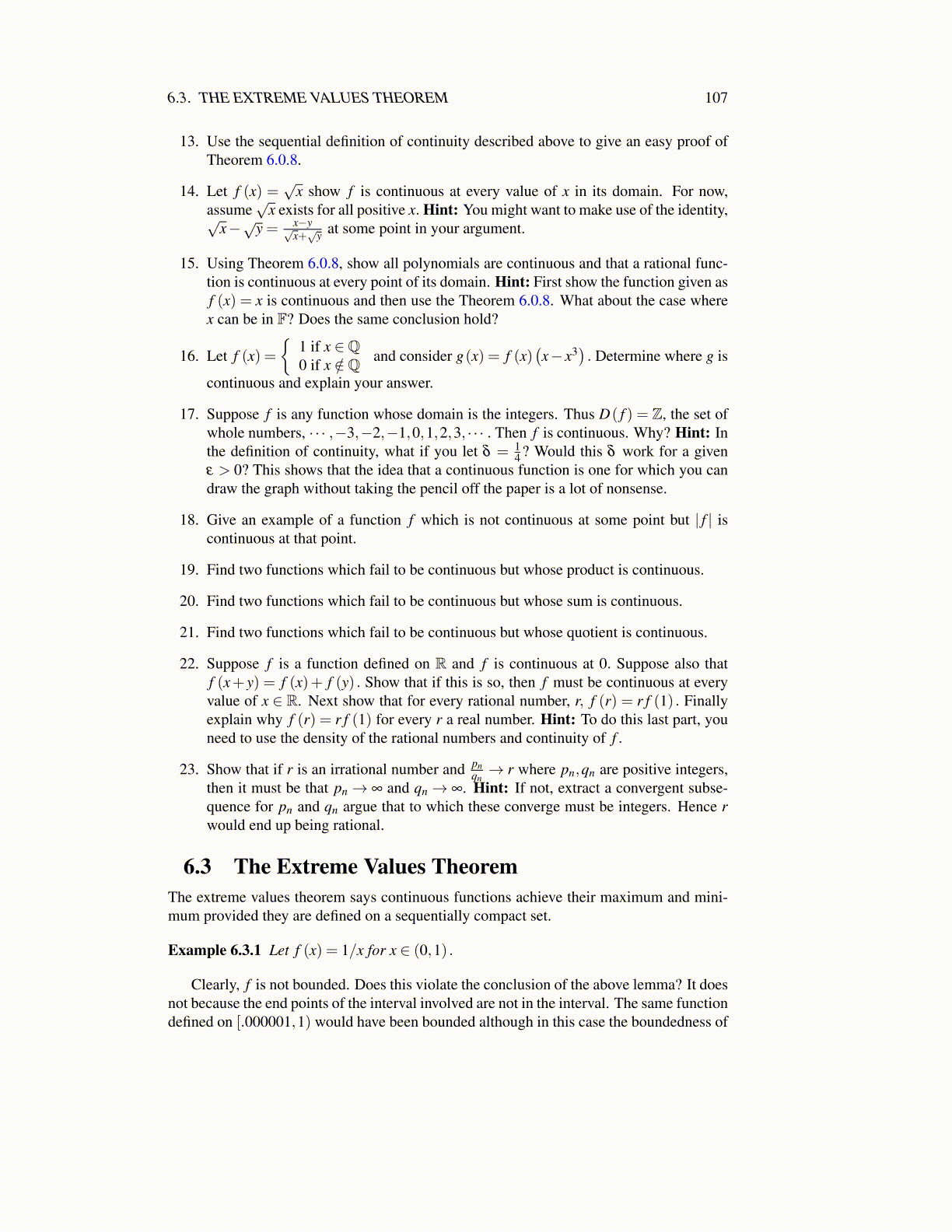
6.4. THE INTERMEDIATE VALUE THEOREM 107
Proof: When we have an interval [an,bn] in this argument, cn will be the midpoint(an +bn)/2. Let a0 = a,b0 = b. If [an,bn] has been chosen such that f (an) f (bn)≤ 0, con-sider [an,cn] and [cn,bn]. Either f (an) f (cn)≤ 0 or f (cn) f (bn)≤ 0 since if both productsare positive, then f (an) and f (bn) are either both positive or both negative contradictingf (an) f (bn) ≤ 0. Pick one of the intervals for which the product is non-positive. Let theleft endpoint be an+1 and the right endpoint be bn+1 so f (an+1) f (bn+1) ≤ 0. Now thesenested intervals have exactly one point in their intersection because they have diametersconverging to 0. Call it x. Then ( f (x))2 = limn→∞ f (an) f (bn) ≤ 0. This is by Theorem6.1.1. Thus f (x) = 0.
It is easy to generalize this Proposition.
Theorem 6.4.2 Suppose f : [a,b]→R is continuous and suppose either f (a)< c <f (b) or f (a)> c > f (b) . Then there exists x ∈ (a,b) such that f (x) = 0.
Proof: Apply the above proposition to g(x)≡ f (x)−c obtaining a point x∈ (a,b) withg(x) = f (x)− c = 0.
Lemma 6.4.3 Let φ : [a,b]→ R be a continuous function and suppose φ is one to one,written as 1− 1 on (a,b). Then φ is either strictly increasing or strictly decreasing on[a,b] .
Proof: First it is shown that φ is either strictly increasing or strictly decreasing on(a,b) .
If φ is not strictly decreasing on (a,b), then there exists x1 < y1, x1,y1 ∈ (a,b) such that
(φ (y1)−φ (x1))(y1− x1)> 0.
If for some other pair of points, x2 < y2 with x2,y2 ∈ (a,b) , the above inequality does nothold, then since φ is 1−1,
(φ (y2)−φ (x2))(y2− x2)< 0.
Let xt ≡ tx1 +(1− t)x2 and yt ≡ ty1 +(1− t)y2. Then xt < yt for all t ∈ [0,1] because
tx1 ≤ ty1 and (1− t)x2 ≤ (1− t)y2
with strict inequality holding for at least one of these inequalities since not both t and(1− t) can equal zero. Now define
h(t)≡ (φ (yt)−φ (xt))(yt − xt) .
Since h is continuous and h(0) < 0, while h(1) > 0, there exists t ∈ (0,1) such thath(t) = 0. Therefore, both xt and yt are points of (a,b) and φ (yt)−φ (xt) = 0 contradictingthe assumption that φ is one to one. It follows φ is either strictly increasing or strictlydecreasing on (a,b) .
This property of being either strictly increasing or strictly decreasing on (a,b) carriesover to [a,b] by the continuity of φ . Suppose φ is strictly increasing on (a,b) . (A similarargument holds for φ strictly decreasing on (a,b) .) If x > a, then let zn be a decreasingsequence of points of (a,x) converging to a. Then by continuity of φ at a,
φ (a) = limn→∞
φ (zn)≤ φ (z1)< φ (x) .
Therefore, φ (a)< φ (x) whenever x ∈ (a,b) . Similarly φ (b)> φ (x) for all x ∈ (a,b).